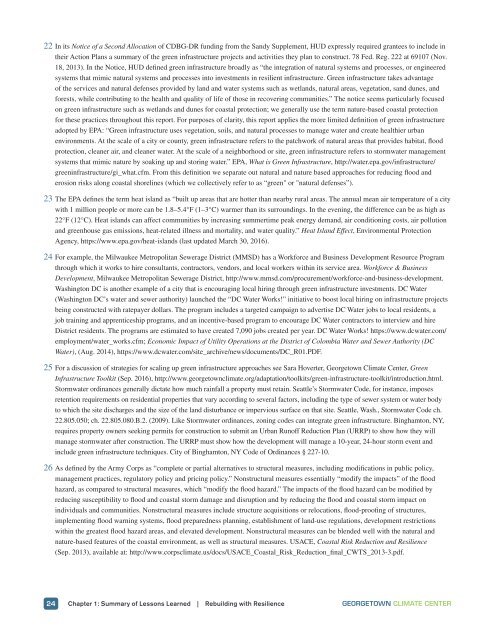Rebuilding with Resilience
dw0r306aHfX
dw0r306aHfX
Create successful ePaper yourself
Turn your PDF publications into a flip-book with our unique Google optimized e-Paper software.
22 In its Notice of a Second Allocation of CDBG-DR funding from the Sandy Supplement, HUD expressly required grantees to include in<br />
their Action Plans a summary of the green infrastructure projects and activities they plan to construct. 78 Fed. Reg. 222 at 69107 (Nov.<br />
18, 2013). In the Notice, HUD defined green infrastructure broadly as “the integration of natural systems and processes, or engineered<br />
systems that mimic natural systems and processes into investments in resilient infrastructure. Green infrastructure takes advantage<br />
of the services and natural defenses provided by land and water systems such as wetlands, natural areas, vegetation, sand dunes, and<br />
forests, while contributing to the health and quality of life of those in recovering communities.” The notice seems particularly focused<br />
on green infrastructure such as wetlands and dunes for coastal protection; we generally use the term nature-based coastal protection<br />
for these practices throughout this report. For purposes of clarity, this report applies the more limited definition of green infrastructure<br />
adopted by EPA: “Green infrastructure uses vegetation, soils, and natural processes to manage water and create healthier urban<br />
environments. At the scale of a city or county, green infrastructure refers to the patchwork of natural areas that provides habitat, flood<br />
protection, cleaner air, and cleaner water. At the scale of a neighborhood or site, green infrastructure refers to stormwater management<br />
systems that mimic nature by soaking up and storing water.” EPA, What is Green Infrastructure, http://water.epa.gov/infrastructure/<br />
greeninfrastructure/gi_what.cfm. From this definition we separate out natural and nature based approaches for reducing flood and<br />
erosion risks along coastal shorelines (which we collectively refer to as “green" or "natural defenses”).<br />
23 The EPA defines the term heat island as “built up areas that are hotter than nearby rural areas. The annual mean air temperature of a city<br />
<strong>with</strong> 1 million people or more can be 1.8–5.4°F (1–3°C) warmer than its surroundings. In the evening, the difference can be as high as<br />
22°F (12°C). Heat islands can affect communities by increasing summertime peak energy demand, air conditioning costs, air pollution<br />
and greenhouse gas emissions, heat-related illness and mortality, and water quality.” Heat Island Effect, Environmental Protection<br />
Agency, https://www.epa.gov/heat-islands (last updated March 30, 2016).<br />
24 For example, the Milwaukee Metropolitan Sewerage District (MMSD) has a Workforce and Business Development Resource Program<br />
through which it works to hire consultants, contractors, vendors, and local workers <strong>with</strong>in its service area. Workforce & Business<br />
Development, Milwaukee Metropolitan Sewerage District, http://www.mmsd.com/procurement/workforce-and-business-development.<br />
Washington DC is another example of a city that is encouraging local hiring through green infrastructure investments. DC Water<br />
(Washington DC’s water and sewer authority) launched the “DC Water Works!” initiative to boost local hiring on infrastructure projects<br />
being constructed <strong>with</strong> ratepayer dollars. The program includes a targeted campaign to advertise DC Water jobs to local residents, a<br />
job training and apprenticeship programs, and an incentive-based program to encourage DC Water contractors to interview and hire<br />
District residents. The programs are estimated to have created 7,090 jobs created per year. DC Water Works! https://www.dcwater.com/<br />
employment/water_works.cfm; Economic Impact of Utility Operations at the District of Colombia Water and Sewer Authority (DC<br />
Water), (Aug. 2014), https://www.dcwater.com/site_archive/news/documents/DC_R01.PDF.<br />
25 For a discussion of strategies for scaling up green infrastructure approaches see Sara Hoverter, Georgetown Climate Center, Green<br />
Infrastructure Toolkit (Sep. 2016), http://www.georgetownclimate.org/adaptation/toolkits/green-infrastructure-toolkit/introduction.html.<br />
Stormwater ordinances generally dictate how much rainfall a property must retain. Seattle’s Stormwater Code, for instance, imposes<br />
retention requirements on residential properties that vary according to several factors, including the type of sewer system or water body<br />
to which the site discharges and the size of the land disturbance or impervious surface on that site. Seattle, Wash., Stormwater Code ch.<br />
22.805.050; ch. 22.805.080.B.2. (2009). Like Stormwater ordinances, zoning codes can integrate green infrastructure. Binghamton, NY,<br />
requires property owners seeking permits for construction to submit an Urban Runoff Reduction Plan (URRP) to show how they will<br />
manage stormwater after construction. The URRP must show how the development will manage a 10-year, 24-hour storm event and<br />
include green infrastructure techniques. City of Binghamton, NY Code of Ordinances § 227-10.<br />
26 As defined by the Army Corps as “complete or partial alternatives to structural measures, including modifications in public policy,<br />
management practices, regulatory policy and pricing policy.” Nonstructural measures essentially “modify the impacts” of the flood<br />
hazard, as compared to structural measures, which “modify the flood hazard.” The impacts of the flood hazard can be modified by<br />
reducing susceptibility to flood and coastal storm damage and disruption and by reducing the flood and coastal storm impact on<br />
individuals and communities. Nonstructural measures include structure acquisitions or relocations, flood-proofing of structures,<br />
implementing flood warning systems, flood preparedness planning, establishment of land-use regulations, development restrictions<br />
<strong>with</strong>in the greatest flood hazard areas, and elevated development. Nonstructural measures can be blended well <strong>with</strong> the natural and<br />
nature-based features of the coastal environment, as well as structural measures. USACE, Coastal Risk Reduction and <strong>Resilience</strong><br />
(Sep. 2013), available at: http://www.corpsclimate.us/docs/USACE_Coastal_Risk_Reduction_final_CWTS_2013-3.pdf.<br />
24 Chapter 1: Summary of Lessons Learned | <strong>Rebuilding</strong> <strong>with</strong> <strong>Resilience</strong> GEORGETOWN CLIMATE CENTER


